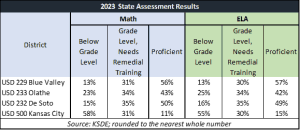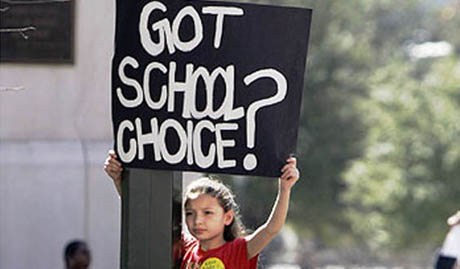The bipartisan Open Enrollment legislation signed into law in 2022 offered hope for students who are trapped by their zip code in underperforming school districts. The law requires districts to accept students within self-determined capacity limits for each grade level unless the transfer applicants have poor records for behavior or attendance.
One might think Open Enrollment would be embraced in the home state of Brown v. Board of Education, which overturned the separate-but-equal principle and outlawed segregation in public schools.
But that wasn’t the case. Kansas public school officials, including the State Board of Education and the Department of Education, strongly opposed Open Enrollment. Two districts — USD 229 Blue Valley and USD 233 Olathe — basically said Open Enrollment would bring undesirable students to their schools, and now it seems both are trying to nearly close their borders with capacity limits.
Blue Valley Superintendent Tonya Merrigan and Olathe Superintendent Brent Yeager said it wasn’t fair for their well-off residents to pay to educate kids from outside the district and reduce property values:
“While we can certainly empathize with parents in lower-performing districts, both Blue Valley and Olathe are among the highest-performing districts in Kansas – indeed competing nationally – and, as such, would find our districts overwhelmed with requests from non-residents. Without intending to sound elitist, it is nonetheless true that housing costs in our districts often provide a check on resident student growth now.
“What we believe our local districts’ taxpayers would find particularly egregious is that their taxes would be paying for non-resident students (emphasis in original), meaning the local resources for our own resident students would be spread even further. While we would receive state BASE aid for these students, the same is not true for capital outlay, bond and interest, and other weightings based on property valuations.”
 By the way, people all across Kansas are helping to pay for kids attending Blue Valley and Olathe with their income tax and sales tax, as local property tax is only a portion of funding for almost every school district.
By the way, people all across Kansas are helping to pay for kids attending Blue Valley and Olathe with their income tax and sales tax, as local property tax is only a portion of funding for almost every school district.
There are tremendous achievement differences between some school districts, even though they may be adjacent. Only 11% of students in USD 500 Kansas City are proficient in math, compared to 56% in Blue Valley, 50% in De Soto, and 43% in Olathe. It’s hard to imagine how parents in the Kansas City district feel about seeing nearby districts with capacity and better outcomes but not being welcome to send their children there for better opportunities.
Arbitrary capacity limits thwart open enrollment
Sentinel reporter David Hicks asked several districts around the state to share their Open Enrollment capacity.
Blue Valley spokesperson Kaci Brutto said the district will have 86 seats for non-resident students in two schools — 46 at Aspen Grove Elementary and 40 at Blue Valley Southwest High School. The other 21 elementary schools, all nine middle schools, and the other four high schools are closed to non-residents.
Brutto says the district placed a 75% capacity limit on each school to allow for future growth; in other words, they are allowing for 25% enrollment growth, which doesn’t seem justified by the district’s enrollment history. This year, for example, the district of almost 22,000 students added just 58 kids for a growth rate of less than half of one percent. Since 2020, the district has lost 460 students.
Olathe is allowing for 20% growth over the next five years, which is also not justified by its enrollment history. USD 233 enrollment has declined by more than 1,400 since 2020, but it will only allow 590 students to transfer in after deciding four elementary schools, two middle schools, and three high schools will be closed to outsiders.
USD 232 De Soto didn’t mention capacity limits, but Communications Director Alvie Carter II says, “We estimate that student enrollment will increase by about 30 (K-12). The rate of growth is key to watch, meaning it could be a higher percentage than what we are predicting.”
Audited enrollment data from KSDE shows the district has lost about 120 students since 2020. Carter says De Soto will accept 34 transfers across five schools, and the other seven schools will be closed to outsiders.
USD 259 Wichita also did not specify capacity limits, but even though it lost more than 3,100 students since 2020, it is only accepting 455 transfers and is excluding six of 12 high schools, 12 of 19 middle schools, and 29 of 56 elementary schools from offering Open Enrollment opportunities.
Some districts welcome students with open arms
While some districts are taking steps to limit Open Enrollment, others have the opposite approach.
Superintendent Patrick McKernan of Troy USD 429 told Hicks, “The USD 429 board of education approved unlimited capacity for the 2024-2025 school year, grades K-12. We don’t anticipate much growth in our county but would love to see it.”
USD 250 Superintendent Richard Proffitt says Pittsburg “will not be setting any capacity limits in our district.”
In Northwest Kansas, Superintendent Mark Penka of St. Francis USD 297 says, “If we are looking at capacity, we have room for roughly 200-250 students to be full with the current buildings that we have now.”
Enrollment in St. Francis is only about 300 students, so the doors seem wide open there.
Open Enrollment information isn’t readily available for all districts in Kansas, but the Sentinel will collect more data and share it here soon.



